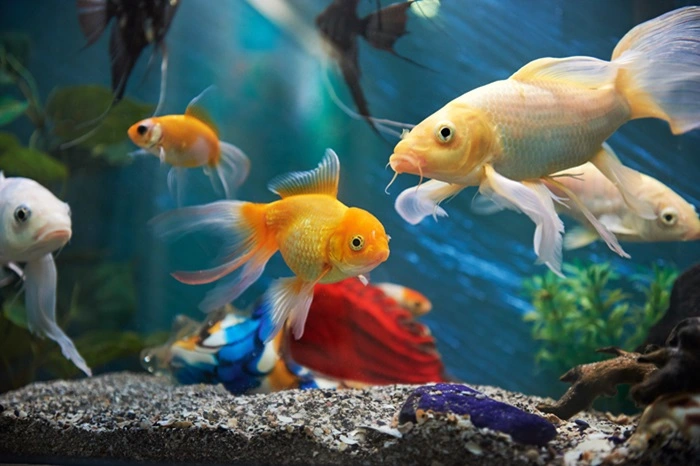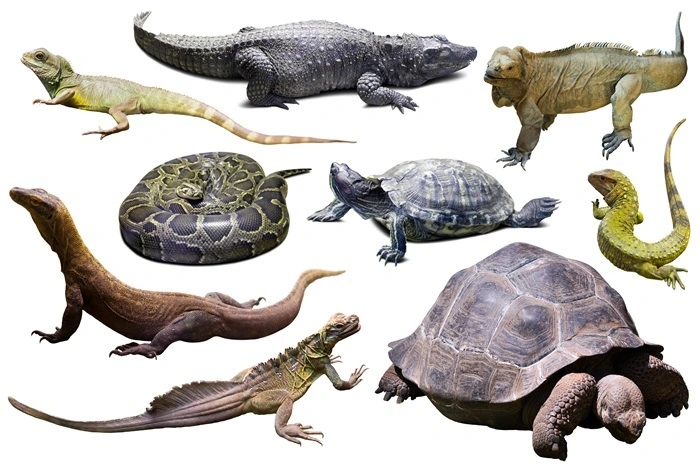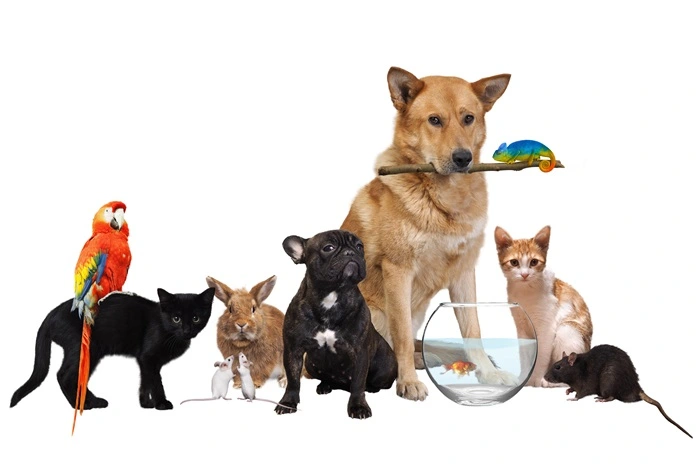1. Dogs
65.1 million Households
2. Cats
46.5 million Households
3. Birds
6.1 million U.S. Households
4. Fish
11.1 million Households
5. Reptiles
6 million U.S. Households
Humans have always had pets because they provide us withhappiness, emotional support, and company. The top 5 most popular pets in the world will be discussed in this article,along with details on their traits, benefits, and problems for pet owners.
Takingup pet ownership is an enjoyable decision that brings happiness, company, and a hint of fun. It's important to select a pet that fits your lifestyle and tastes. Today, we'll examine the glamour of the top five pets that have wonhearts worldwide. Whether furry or feathered, these adorable pets add love and affection to any house.
Choosing a family pet is an important decision that will impact the well-being of the being you're considering bringing into your house andthe quality of your everyday life. When choosing the kind of pet that's best for you, there are many things to consider. A few of these are budget, space, activity level, and time commitment.
We will discuss the top 5 most popular pets in the world. These are explained below:
Top 5 most popular pets in the world
the top 5 most popular pets in the world are listed below.
1. Dogs
65.1 million Households
 Dogs are the most popular pets, referredto as man's best friend. Dogs suit variouslifestyles because of their endless energy, loyalty, and variety of breeds. There is a dog friend for everyone, whether you enjoy.
Dogs are the most popular pets, referredto as man's best friend. Dogs suit variouslifestyles because of their endless energy, loyalty, and variety of breeds. There is a dog friend for everyone, whether you enjoy.
With over 400 million domesticated dogs globally, dogs arethe second most popular pets worldwide. They need more care and attention than cats since they areloyal and protective. To remain healthy and happy, dogsneed regular exercise and training.
Dogs havebecome especially suited to human behavior, and research on the relationship between humans and dogs has continued. They have earned the nickname "man's best friend" due totheir impact on human culture.
- Anatomy of dogs: Except forthe number of bones in the tail, all healthy dogs, regardless of size or breed, have the same skeletal structure, albeit there is some variationbetweendogs. The dog's skeleton is well suited for running; the long ribs allow room for the heart and lungs; the shoulders are adaptive because they are not attached to the skeleton; and the vertebrae on the neck and back have extensions for the back muscles, which are made up of epaxial and hypaxial muscles, to connect to.
- Dogs Senses: The senses that dogs possess are vision, hearing, taste, smell, touch, and magneto reception. According to one study, dogs may be able toidentify minute changes in the Earth's magnetic field. Dogs prefer to urinate with their spines aligned north-south when there is a peaceful magnetic field.
2. Cats
46.5 million Households
 With over 500 million domestic cats worldwide, cats are the cutest pets in the world. They have become known for their devotion and affection towards their owners andindependent animals who need little care.
With over 500 million domestic cats worldwide, cats are the cutest pets in the world. They have become known for their devotion and affection towards their owners andindependent animals who need little care.
In temperate zones, female domestic cats can bear kittens from spring to late fall; in equatorial climates, they can bear kittens all year round. Typically, a litter of two to five kittens is produced. Cat Fancy is the hobby of producing domestic cats for exhibitionsas registered pedigreed cats at events.
With 95.6 million cats owned and about 42 million households having at least one cat, domestic cats were the second most common pet in the US as of 2017. In the UK, 10.9 million cats are expected to be owned by humans by 2020, which represents 26% of all cats.
Anatomy of Cats
- Size: The domestic cat has shorter bones and a smaller skull than the European wildcat. Its typical size is 23–25 cm (9.1–9.8 in) in height, 46 cm (18 in) in length from head to body, and 30 cm (12 in) long tails. Men are bigger than women. Typically, adult domestic cats weigh between 4-5 kg (8.8-11.0 lb).
- Skeleton: Cats share many characteristics with humans, including having seven cervical vertebrae, 13 thoracic vertebrae, seven lumbar vertebrae, three sacral vertebrae, and a variable number of caudal vertebrae in the tail (humans only have three to five vestigial caudal vertebrae, fused into an internal pelvic).
3. Birds
6.1 million U.S. Households
 With over 100 million pet birds worldwide, birds rank third in popularity as pets. They are well-liked by bird lovers and are well-known for being capable of singing and whistling. Birds need specific treatment and repair, such as a balanced diet, regular exercise, and socialization.
With over 100 million pet birds worldwide, birds rank third in popularity as pets. They are well-liked by bird lovers and are well-known for being capable of singing and whistling. Birds need specific treatment and repair, such as a balanced diet, regular exercise, and socialization.
Feathered friends bring beauty and song into any house. With their colorful feathers and engaging songs, birds bring charm, from the chatty parakeets to the amazing cockatoos. Their lively nature and capacity for sound replication produce an engaging and funny atmosphere.
As warm-blooded animals, birds are members of the Aves class. They can be identified by their feathers, hard-shelled eggs, beaked jaws, high metabolic rates, four-chamberedhearts, and strong yet lightweight skeletons.
- Genomics of Birds: Only two bird’s genomes had been sequenced as of 2010: the zebra finch and the chicken. As of 2022, 542 bird species had full genomes. There is at least one sequenced genome for each order. The genomes of 542 bird species were complete as of 2022. Every order has at least one genome that has been sequenced. Around 90 per centof the extant bird families have at least one species in these.
Bird Anatomy
- Skeletal System: The bones that make up the skeleton are extremely light. They have sizable pores filled with air, known as air cavities, that link to the respiratory system. Adult skull bones are fusedand lack cranial sutures. The eyeballs are housed in huge orbital spaces that are divided from one another by a bony septum.
4. Fish
11.1 million Households
 With over 100 million pet fish worldwide, fish isthe fourth most popular pet worldwide. They are well-liked by those looking for a low-maintenance pet because of their calming and relaxing effects. Fish need a specifichabitat, as well as regular feeding and cleaning.
With over 100 million pet fish worldwide, fish isthe fourth most popular pet worldwide. They are well-liked by those looking for a low-maintenance pet because of their calming and relaxing effects. Fish need a specifichabitat, as well as regular feeding and cleaning.
Fish are wonderful companions for anyone who enjoys the calm beauty of the undersea world. Building up an aquarium with various species and vivid colours can be exciting. Fish may give peace and beauty to your living area, from the elegant Betta fish to the fascinating patterns of a Discus.
- Taxonomy of Fish: As a mutually exclusive group, fishes are no longer formally classified under the Pisces classin older reference works. Fish are generally placed into two classes: the living classes, the extinct classes.
- Habitats of Fish: Accordingly, around 15,200 freshwater species and 14,800 marine species are in freshwater and marine (oceanic) environments. Marine fish diversity is greatest in the Indo-Pacific region's coral reefs, while continental freshwater fish diversity is highest in the huge river basins of tropical rainforests, particularly the Amazon, Congo, and Mekong basins.
- Parasites and Predators Fish: Fish experience parasitism much like other animals do. Certain species clean their fish to get rid of external parasites. The blue streakcleaner wrasses located on coral reefs in the Indian and Pacific oceans are the most well-known. These tiny fish keep up cleaning stations where other fish gather and show specific behaviours to get the cleaners' warning.
5. Reptiles
6 million U.S. Households
 There are more than 10 million pet reptiles worldwide, making them the fifth most popular animal worldwide. They are well-liked by those looking for an interesting and different kind of pet. Reptiles need certain diets and care, such as temperature regulation in their habitat.
There are more than 10 million pet reptiles worldwide, making them the fifth most popular animal worldwide. They are well-liked by those looking for an interesting and different kind of pet. Reptiles need certain diets and care, such as temperature regulation in their habitat.
Pet reptiles are unique and fascinating animals that may spark interest and provide enjoyment. They are ideal for those who prefer a pet other than the typical cats and dogs. Reptiles need unique housing and repairs, which can be costly and time-consuming. Certain food and environmental needs must be satisfied for each reptile species to succeed.
A tetrapod reptile group is usually categorized as having amniotic development and an ectothermic (or "cold-blooded") metabolism. There are four orders of living reptiles: the testudines (turtles), the crocodilia (crocodilians), the squamata (snakes and lizards), and the rhynchocephalia (tuatara).
- Sound Production: Reptiles are less talkative than frogs, birds, and mammals. Typically, the only sound created is hissing, which is not considereda proper vocalization because it is simply the result of forcing air through a partially closed glottis. Crocodilians, some lizards, and turtles may all make vocalizations, which usually involve vibrating structures in the larynx or glottis that resemble folds.
- Hearing in snakes:
Human hearing depends on the ear's three parts:
- The inner ear aids in balance and hearing.
- The middle ear relays incoming sound waves to the inner ear.
- The outer ear sends sound waves into the ear canal.
Snakes have an inner ear structure with the cochlea directly attached to their jawbone, unlike humans and other animals, withan outer ear, middle ear, and tympanum.
Benefits and Challenges of Pets
Benefits of pets:
|
Pet |
Benefits |
|
Dogs |
Provide loyalty, protection, companionship, and emotional support. It can be helpful for those who suffer from anxiety or sadness. |
|
Cats |
They areideal for busy peoplebecause they require fewer repairs. Give comfort and emotional support to those who have difficulty with mental health concerns. |
|
Birds |
Arrange social events and entertainment. Able may be trained to carry out a variety of jobs. |
|
Fish |
Calm and relaxing. It maydecrease anxiety and tension in low-careanimals. |
|
Reptiles |
Petsare unique and fascinating and can be interesting and entertaining. Different from typical dogs and cats. |
Challenges of Owning Each Pet:
- Dogs: To keep fit and content, dogs mustbe trained and exercised frequently. They also need interaction and socialization with their owners.
- Cats: Some people get allergies from cats, which can be difficult for those withallergies.
- Birds: Birds need specific treatment and environments, which can be costly and time-consuming.
- Fish: Fish need specific kinds of habitat, as well as regular feeding and cleaning.
- Reptiles:Reptiles need particular care and maintenance, which can be costly and time-consuming. Certain dietary and environmental needs must be satisfied for each reptile species to flourish.
Conclusion:
In conclusion, cats, dogs, birds, fish, and reptiles are the most common pet animals worldwide. Every pet has unique qualities, advantages,disadvantages, and benefits. Your living situation, way of life, and financial constraints should all be consideredwhen selecting a pet. It's important to provide your pet withthe care and attention they require to live a happy and healthy life since owning a pet is a responsibility. If you're thinking about getting a pet, do your homework on the demands of the particular animal and come to a well-informed decision.
Frequently Asked Questions
Q. What are the top 5 most common pets in the world?
Dogs (65.1 million households) Cats (46.5 million households) Freshwater fish (11.1 million households) Small animals such as hamsters, gerbils, rabbits, guinea pigs, chinchillas, mice and ferrets (6.7 million households).
Q. What pet is the cleanest?
While cats are known for being extremely neat, they often leave hairballs, trails of litter, and other waste for their humans to clean up. Fish, reptiles, amphibians, and rodents make the cleanest pets.
Q. Which pet is the more friendly?
Dogs can make excellent companions for children, providing fun and a great opportunity to learn responsibility. Some kid-friendly dog breeds are Shih Tzu, Labrador, Beagle, and Golden Retriever.






